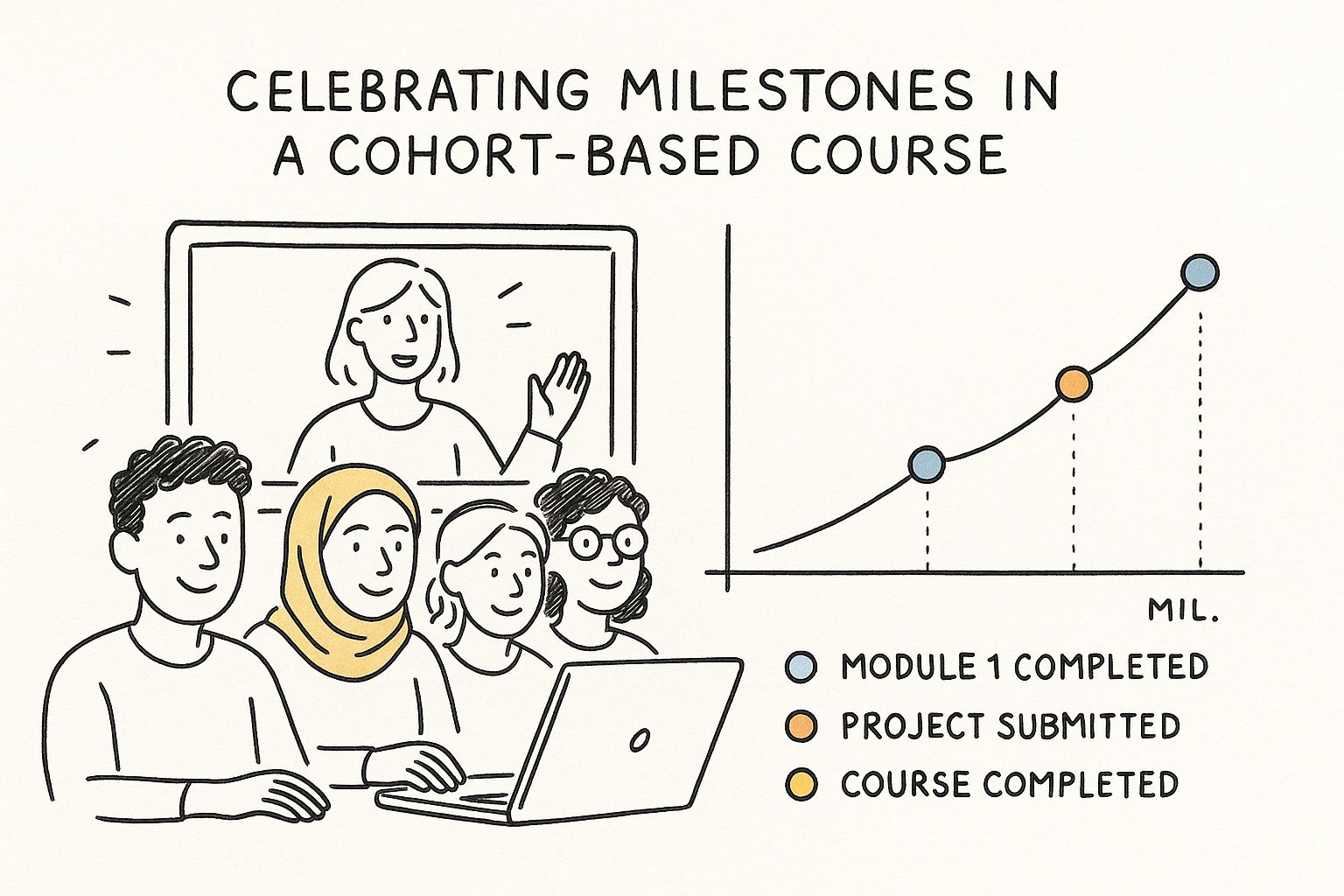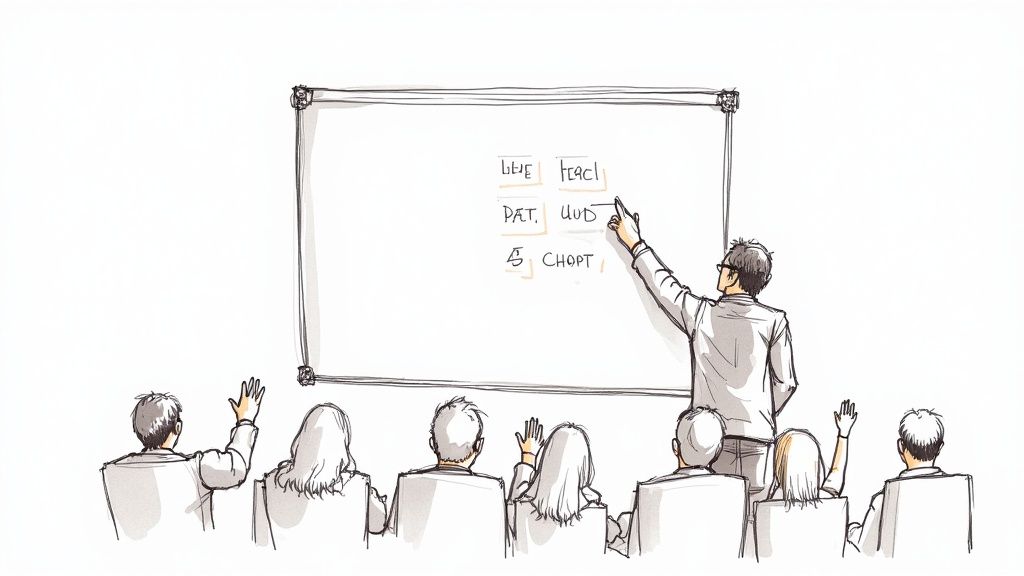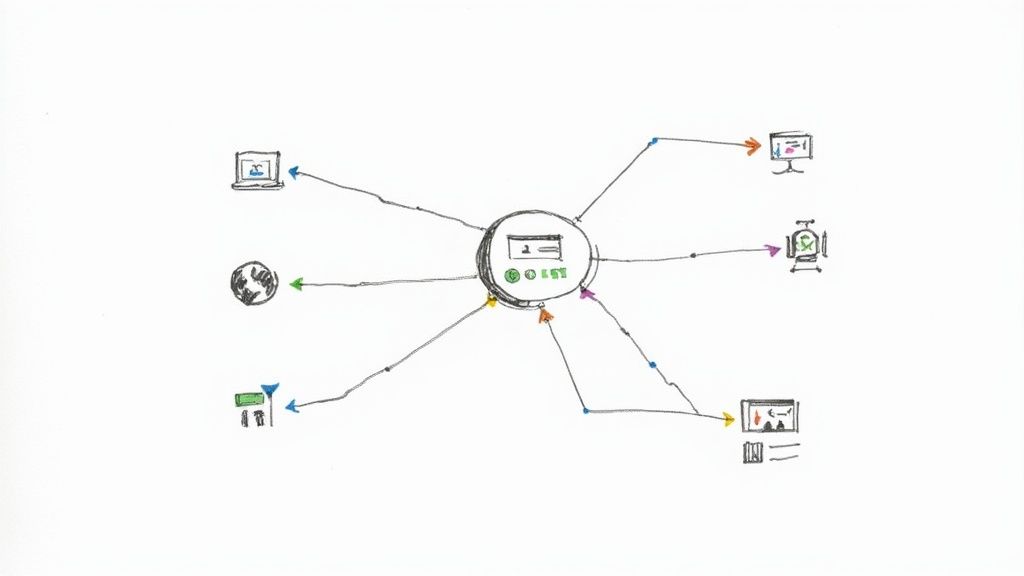August 21, 2025

At its core, a cohort-based course is a shared learning adventure. A specific group of students—the cohort—starts the course, moves through the material, and finishes it all together on the same schedule. It’s a huge departure from the go-at-your-own-pace model, focusing instead on live interaction, community support, and structured progress.
Think of it as a guided, collaborative journey, not a solo mission.
Imagine you've decided to climb a mountain. A typical self-paced online course is like being handed a map and a compass at the trailhead with a simple "good luck." You have the tools, sure, but the journey is lonely, your motivation is entirely on you, and it’s incredibly easy to get discouraged, lost, or just give up.
A cohort-based course is the exact opposite. It’s like signing up for a professionally guided expedition.
In this setup, you’re never learning alone. You're part of a team with a clear start date, planned milestones along the way, and a shared summit to reach. This simple shift in structure completely changes the learning dynamic.
The real magic of the cohort model comes from a few core elements that work together to create an environment that’s not just engaging, but genuinely effective.
This collaborative structure is the antidote to the isolation that leads to abysmal completion rates in traditional online learning. It builds a foundation for real transformation, not just information transfer.
This move toward collaborative online learning isn't just a trend; it's getting incredible results. Research shows students in cohort programs have a completion rate 3.6 times higher than those in standard non-cohort courses. That massive jump is driven by social accountability and a genuinely supportive peer environment. You can explore more data on cohort model effectiveness to see just how big the impact is.
This shared journey turns a lonely climb into a collective achievement.
The secret to a great cohort-based course isn’t just the content—it’s the psychology. It taps into something fundamental about how we learn best: together. Unlike the often lonely road of self-paced learning, cohorts create a vibrant, active environment built on shared goals, real accountability, and live interaction.
This simple shift from passive video-watching to active participation makes all the difference. When you know a live session is on the calendar or a group project is due, the material suddenly becomes a priority. It's no longer something you can just push to next week. This structure is a powerful antidote to procrastination, which is the number one enemy of finishing a solo online course.
Think of accountability as the engine that drives a cohort forward. There’s a subtle but powerful social pressure that kicks in when you know your peers are all making progress. If you fall behind, you're not just letting yourself down; you're stepping away from the group's momentum.
This shared journey turns learning from a solitary task into a team sport. It's why Massive Open Online Courses (MOOCs) have notoriously high dropout rates, sometimes over 90%—there's simply no connection. In stark contrast, well-run cohort courses often boast completion rates that can climb as high as 90%.
The collective energy of a group working toward the same goal keeps everyone more committed. When you see others tackling the same challenges you are, the entire process feels more motivating, engaging, and, most importantly, achievable.
This level of engagement is a game-changer for long-term success. For more ideas on keeping your students locked in, you can explore other strategies for improving retention and lasting growth that build on these same principles.
This image really captures that feeling—a diverse group of learners coming together in a digital space to celebrate their shared progress and achievements.

It’s this collaborative spirit and sense of belonging that truly defines the cohort experience.
When you put the two main online learning formats side-by-side, the differences become crystal clear. A cohort-based course is intentionally engineered for connection and completion, while a self-paced model prioritizes total flexibility, often at the cost of students actually finishing.
Let's break down how they stack up.
Ultimately, a cohort-based course creates a true learning ecosystem. It surrounds students with support from all sides—expert guidance from the instructor, encouragement from their peers, and a clear path forward. This model consistently produces better results because it’s designed around the way people have always learned best: with each other.
A truly great cohort-based course isn’t an accident. It’s intentionally built on three core pillars that work together to create an experience that’s about more than just watching videos. When you get these right, you’re paving the way for real skill development and connections that last.
These pillars are the Structured Curriculum, the Vibrant Community, and the Interactive Live Events. Think of them as the legs of a stool—if one is weak, the whole thing wobbles. Let’s break down what makes each one so important.
Your curriculum is the roadmap for the entire journey, giving students a clear, logical path from where they are to where they want to be. In a cohort course, though, a great curriculum is more than just a list of modules. It’s a smart mix of self-paced learning and hands-on practice that respects everyone's busy schedules.
This is often called a "flipped classroom" model, and it works beautifully. Students can watch pre-recorded lessons and absorb the core ideas on their own time. This frees up the invaluable live sessions for what really matters: asking deep questions, workshopping ideas, and getting direct feedback from you and their peers.
A well-designed curriculum provides structure and direction, ensuring the entire cohort moves forward with a shared sense of momentum and purpose. It’s the map everyone follows on their collective journey.
Building a curriculum that actually helps people learn requires a bit of know-how. To go deeper on this, you can learn more by mastering instructional design principles.
The second pillar is the community—this is the real heart and soul of the course. It’s where the collaborative magic happens and where students go from being passive learners to active, engaged members of a team. A strong community motivates people, keeps them accountable, and makes the whole experience richer.
This dedicated space, whether it’s in a Slack channel, a Circle community, or built into a platform like GroupOS, is where students can:
Getting a community to thrive takes a little nudge. You can spark conversations with simple icebreakers, post weekly discussion prompts, or set up peer feedback loops. The aim is to create a safe, supportive space where everyone feels like they belong.
Finally, your live events are where the curriculum and community truly come together. These scheduled sessions are the premium, high-touch moments that make a cohort-based course so much more powerful than a static, self-paced video library. They turn learning from a lonely activity into a shared, energetic experience.
The key is to design these events for active participation, not just passive listening. Some of the most effective formats include:
These events create natural deadlines and give students priceless opportunities for real-time feedback. For more inspiration on designing engaging live sessions, check out our guide on how to run a mastermind event. When all three pillars are strong, they work in harmony to create real, lasting transformation for your students.

The right technology makes a great cohort-based course feel effortless. It lets your students dive into the learning without getting tripped up by clunky logistics. Building a solid tech stack isn't about finding one magical, all-in-one tool. It’s about picking a few key platforms that work together to create a smooth, intuitive journey for your learners from the moment they sign up.
Think of your tech stack as the backstage crew for your course. Each piece has a specific job to do. When they all work in sync, the on-stage performance—the student experience—is flawless. Your goal is to choose tools that actually boost interaction, make tracking progress simple, and support the vibrant community you're working so hard to build.
To deliver a truly premium experience, you really need to nail three areas: curriculum hosting, live sessions, and community management. Each one plays a critical role in how your cohort feels and functions.
Choosing the right tools is a strategic decision that directly impacts student engagement. A clunky, disjointed experience can lead to frustration and dropouts, while a seamless one makes learners feel supported and focused.
The real magic happens when you make these separate tools feel like a single, unified system. Your students shouldn't have to juggle multiple logins and confusing interfaces. This is where integrations are absolutely essential. If you’re looking to connect different platforms, a practical API integration tutorial can be a lifesaver.
This integrated approach is precisely why so many creators are seeing incredible results. In fact, a growing number of course creators—around 70-80%—now use cohort models, using technology to drive up student engagement and completion rates. And it works. Analytics consistently show that active participation in live sessions often exceeds 85%, which just goes to show that a well-supported, tech-enabled environment keeps learners deeply invested.
For those looking to build a community-centric business model, it's also worth checking out our guide on https://groupos.com/blog/how-to-create-a-membership-website, as many of the same principles apply. Ultimately, your tech stack should fade into the background, allowing the learning and the community connection to take center stage.

Moving from a great idea to a sold-out course takes more than just good content; it requires a smart, strategic launch plan. A well-executed launch for your cohort based course does more than just fill seats. It attracts the right students, establishes clear expectations, and builds a powerful sense of momentum right from the start.
This whole process really gets going long before you even think about opening the cart. Let's break down the essential steps.
Before you even dream of writing a single sales page, you need to know exactly who you're talking to. And I don't mean vague demographics. I mean getting deep into their heads to understand their biggest frustrations, their most ambitious goals, and what keeps them up at night.
Nailing this profile is what makes your course content and your marketing connect on a gut level. It pulls in the people who are genuinely ready to do the work and get results.
Ask yourself these questions:
Getting these answers helps you build a course that feels like it was made just for them.
Here’s a common mistake: pricing a cohort based course like it’s just a collection of videos. It’s not. You’re selling a high-touch, guided experience. You’re selling direct access to your brain, a built-in support system, and real accountability. Your price has to reflect that.
A good rule of thumb is to price a cohort course 3x to 10x higher than a similar self-paced program. This frames it correctly—as a premium investment in a real outcome, not just another digital product.
Your marketing needs to sing this from the rooftops. Don’t just talk about the modules; talk about the magic of learning together. Emphasize the networking, the live Q&As, and the shared "we're in this together" journey. The community and direct support are what people are really paying for.
The student experience doesn't start on day one of class; it starts the second they hit "buy." A smooth, welcoming onboarding process is your best defense against buyer's remorse and the perfect way to get everyone fired up. You want new students to feel seen, prepared, and totally confident they made the right call.
A solid onboarding flow should cover these bases:
This kind of proactive welcome sets a fantastic tone for the entire course. It gets everyone on the same page and excited to hit the ground running when the cohort officially kicks off.
Even when you've got a solid plan, a few practical questions always pop up once you start building your first cohort-based course. Let's tackle some of the most common ones so you can move forward with confidence.
Think of this as your go-to cheat sheet for fine-tuning your strategy, covering everything from how much time you'll really spend to how many people to let in the door.
This is probably the number one question I hear. Let's be real: running a cohort-based course is definitely more hands-on than a self-paced one. That’s because of the live sessions and the community you need to nurture.
A typical week usually involves 2-4 hours of live teaching or Q&A sessions. On top of that, you should plan for another 3-5 hours for things like engaging in your community forum, giving feedback on assignments, and handling the little administrative tasks that crop up.
The trick is to block this time out on your calendar from the start. It creates a routine that feels sustainable, not overwhelming.
While the time commitment is higher, the student outcomes are significantly better. This superior experience justifies the premium pricing model and often leads to more fulfilling work for the instructor.
There's no single magic number here. The right size really hinges on your course goals and how much one-on-one time you want to give.
No matter the size, the main goal is always the same: keep that sense of connection and community alive from start to finish.
Absolutely! In fact, I highly recommend it. Blending pre-recorded content with live interaction is one of the most powerful ways to structure a cohort-based course. People often call this the "flipped classroom" model, and for good reason.
Have your students watch the core concepts and foundational lessons on their own time through pre-recorded videos. This simple move frees up your precious live session time for the stuff that truly makes a difference:
This hybrid approach respects your students' schedules while making sure your time together is as impactful as possible.
Pricing is where so many creators sell themselves short. A cohort-based course is a premium, high-transformation experience, and your price has to reflect that.
Remember, you're not just selling information. You are selling direct access to your expertise, a clear path to a result, built-in accountability, and a powerful professional network. That is incredibly valuable.
A solid rule of thumb is to price your cohort course anywhere from 3 to 10 times more than you would charge for a similar self-paced version. This positioning immediately signals the immense value and superior results students can expect when they join a live, community-driven program.
Ready to build a thriving community around your course? GroupOS provides all the tools you need to manage your members, host events, and deliver content seamlessly. Start your journey and see how easy it can be.


